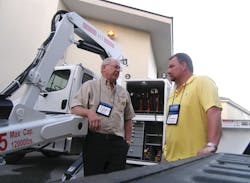On the tire side, higher speed is a goal. So are all-season tires for year-round operations, especially in winter.
On the legislative side, the direction of the Federal Aid Highway Bill is a concern to tire manufacturers and dealers alike. The Tire Industry Association (TIA) hopes to, shall we say, “guide” the process.
Here’s the twist. These trends and issues were not addressed at a gathering of passenger and light truck tire dealers or medium truck tire dealers. They were topics of discussion by off-the-road tire dealers at the 2014 Off-the-Road Tire Conference in Marco Island, Fla., in February. The number of attendees was a conference record.
The 2015 OTR Tire Conference, sponsored by TIA, will be held in Tucson, Ariz., Feb. 18-21 at the Westin La Paloma Resort & Spa.
OTR trends in 2014
Last year, OTR tire unit sales were down 21% compared to 2012, partially due to challenges in the coal mining segment, said Tim Easter, director of OTR tire sales for Yokohama Tire Corp. However, they are expected to rise each of the next four years.
“Overall, total OTR tire growth in the U.S. is expected to be marginal this year at 4.3% and then decline to around 1.5% growth in 2017. Radial OTR growth in the U.S. is expected to be about 5.6% this year and then decline over the next three years to approximately 1.6% in 2017.”
Easter outlined the make-up of the market, which he defined as predominantly tires 24 inches and larger. He told attendees that based on rim diameter, close to 80% of all units sold are made up of the following six segments (with their respective percentages of the entire market in parentheses):
• 24-inch bias (11.6%) and 25-inch bias (16.3%);
• 24-inch radial (10%) and 25-inch radial (29.35%);
• 49-inch radial (4%); and
• greater than 51-inch radial (9.25%).
The overall market was 67.9% radial in 2013, said Easter. He predicted radialization will rise slightly to 68.2% in 2017.
TIA and the highway bill
Roy Littlefield, executive vice president of TIA, told attendees that Congress will again attempt to enact a five-year — or more — Federal Aid Highway Bill this year. The big question will be how the Highway Trust Fund is funded (Federal Excise Tax revenue accounts for less than 2% of the fund’s receipts).
TIA wants to eliminate the use of Highway Trust Fund revenue for non-highway purposes, which Littlefield said is approaching 30%. TIA supports the bipartisan Partnership to Build America Act, a creative effort to find new funding for roads, bridges and transit.
“Without Congressional action, the Highway Trust Fund will run out of money by the end of August this year,” he said. “I believe that Congress will pass a highway bill in 2014, but I also believe that will not happen until after the November elections.”
Littlefield is one of the reasons why TIA’s influence on Capitol Hill has never been stronger. He is not only executive vice president of TIA, but also president of the Small Business Legislative Council and treasurer of the American Highway Users Alliance. ■




